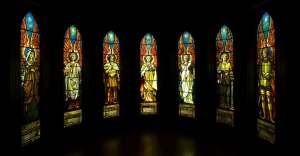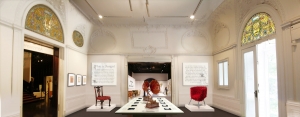|
Displaying items by tag: stained glass
The colorful, stained-glass effect decor items produced by Tiffany Studios represent some of the most beautiful and quintessential specimens of pre-war design such as the Oriental Poppy lamp, which sold for $1.1 million at Sotheby’s in New York this past May. As a painter, Louis Comfort Tiffany was fascinated with the interplay of light and color, and using opalescent glass as his canvas, created masterful renderings of nature — such as flowers or landscape scenes — and decorative geometric patterns in lampshades and leaded-glass windows that popped with color and texture.
London's Serpentine Galleries have revealed the design for the institution's 15th annual summer Pavilion.
Madrid-based architects SelgasCano have released preliminary images showing an amorphous, double-skinned, polygonal structure consisting of translucent, multi-colored fabric membrane made of EFTE panels woven through.
Visitors will be able to pass through the structure via one of the multiple entrances or pass between the outer and inner layer of the building to admire the Pavilion's stained glass interior.
Marc Chagall's drafts for the famous stained-glass windows at the St. Stephen Church in Mainz, Germany, designed in 1982 will go on display in the city next week before joining the permanent collection of the Diözesanmuseum (Diocesan Museum) in Tübingen, "Art Magazin" reports.
The hand-sketched plans for the magnificent blue windows were purchased for €70,000 ($78,000) by a group of local businessmen and the chairman of the Board of Trustees of the St. Stephan Church. The plans became available after they failed to sell at a Sotheby's auction in New York last year.
The collector, scholar and legendary gossip Horace Walpole woke one morning in June 1764 in the extraordinary fantasy home he had created near the Thames, west of London.
Strawberry Hill had – and now has again after years of careful restoration – roof, battlement and mantelpieces bristling with spires and gargoyles, stairs and bookcases copied from the tombs of medieval kings. Its passageways and library ceilings were embellished with imagined ancestors, and windows glitter with stained glass collected by the crate load from across Europe.

On Friday, February 6, 2015, the Blanton Museum of Art announced that it will acquire and construct Ellsworth Kelly’s only building. Kelly, an American painter, sculptor, and printmaker associated with Color Field painting, hard-edge painting, and Minimalism, conceived the stand-alone structure in 1986 for a private collector. At the age of 91, he is finally seeing the project come to fruition.
Austin, a 73-by-60-foot stone building, will be constructed on the museum’s grounds at the University of Texas at Austin. The structure will feature luminous colored glass windows, a totemic wood sculpture, and fourteen black-and-white stone panels in marble -- all designed by the artist. Kelly has gifted the Blanton the design concept for the work, including the building, the totem sculpture, the interior panels, and the glass windows. Once it is complete, Austin will become part of the museum’s permanent collection. The Blanton has launched a campaign to raise $15 million to realize the project and has received commitments totaling $7 million.

In 1964, Cincinnati’s Swedenborgian Church of the New Jerusalem was razed for the construction of a highway. The spiritual home to followers of the 18th-century Swedish scientist and theologian Emanuel Swedenborg, the church was built in 1902, at which time it received the gift of seven stained-glass windows produced by Tiffany Studios, the pre-eminent American producer of stained and art glass, under the direction of the firm’s founder and head, Louis Comfort Tiffany (1848-1933). Unlike many Tiffany windows that perished when their buildings faced the wrecking ball, these were preserved. For decades they sat in crates, hidden away in basements and garages of parishioners, and eventually a barn in Pennsylvania. Only when the barn began to leak in 2001 did a newly appointed minister open the crates. To her astonishment, that which was lost was found again—and even covered with decades of grime, the unique Tiffany beauty of all seven windows, each emblazoned with a life-size stained-glass angel, made a powerful impression.

In 2008, the Cooper Hewitt, Smithsonian Design Museum (formerly the Cooper Hewitt, National Design Museum) embarked on a sweeping renovation of its home -- New York City’s landmark Andrew Carnegie Mansion. Founded in 1896, the museum has been housed in the massive Georgian structure, brimming with wood-paneled walls, stained glass, and carved ceilings, since 1976. Dedicated to historic and contemporary design, the institution hoped to create a space that better communicated its devotion to design evolution.
On December 12, following a three-year closure, the Cooper Hewitt will unveil its renovated and redesigned home to the public. The project, which cost approximately $91 million to complete, added sixty-percent more exhibition space, allowing the institution to present more of its monumental collection and temporary exhibitions. The revamped space also includes a new shop, casework, and movable displays designed by Diller Scofidio + Renfro, a new public staircase, a new freight elevator, and a redesigned outdoor garden by Hood Design.
A rare Grant Wood sketchbook from 1929 is back in Davenport after it went missing from a museum about 50 years ago, the museum said.
The 100-page sketchbook signed by Wood, the painter of "American Gothic," is again in the Figge Art Museum's possession, collections and exhibitions manager Andrew Wallace said Thursday.
The small book of drawings for the 24-foot, stained-glass window in Cedar Rapid's Veterans Memorial Building was likely stolen during an open house in 1966 at what was then the Davenport Museum of Art.
When Aimé Maeght, a French art dealer, lost his young son to leukemia in the 1950s, a trio of formidable modern painters—Georges Braque, Joan Miró and Fernand Léger—persuaded him to turn the family’s summer retreat above the hills of Nice into an artists’ haven. The Marguerite and Aimé Maeght Foundation is 50 years old this month, and still bears abundant traces of the artists who made it happen: a magical Miró labyrinth, mosaics and stained glass by Braque. Its collection of 12,000 works includes 35 sculptures by Alberto Giacometti, as well as masterpieces by Pierre Bonnard, Marc Chagall, Miró, Léger and Alexander Calder, among others. On average, 200,000 visitors tour its colourful galleries and garden every year.
Behind the idyllic exterior, though, the institution is vulnerable. The foundation is finding it hard to raise its €3m ($4m) annual budget.
In 1855, Edward Burne-Jones and William Morris, student friends at Oxford, decided to abandon their theological studies and become artists. They turned for guidance to Dante Gabriel Rossetti, a leader of the recently disbanded Pre-Raphaelite Brotherhood (1848-1853), a group that galvanized British painting by rejecting academic convention and sought to emulate the vividness and sincerity of art from before the time of Raphael.
The creative dialogue between Burne-Jones, Morris, and Rossetti was remarkable for its intensity, productivity, and duration, and stimulated fresh goals and styles that defined the second wave of Pre-Raphaelite art, in the key decades from the 1860s through the 1890s.
|
|
|
|
|